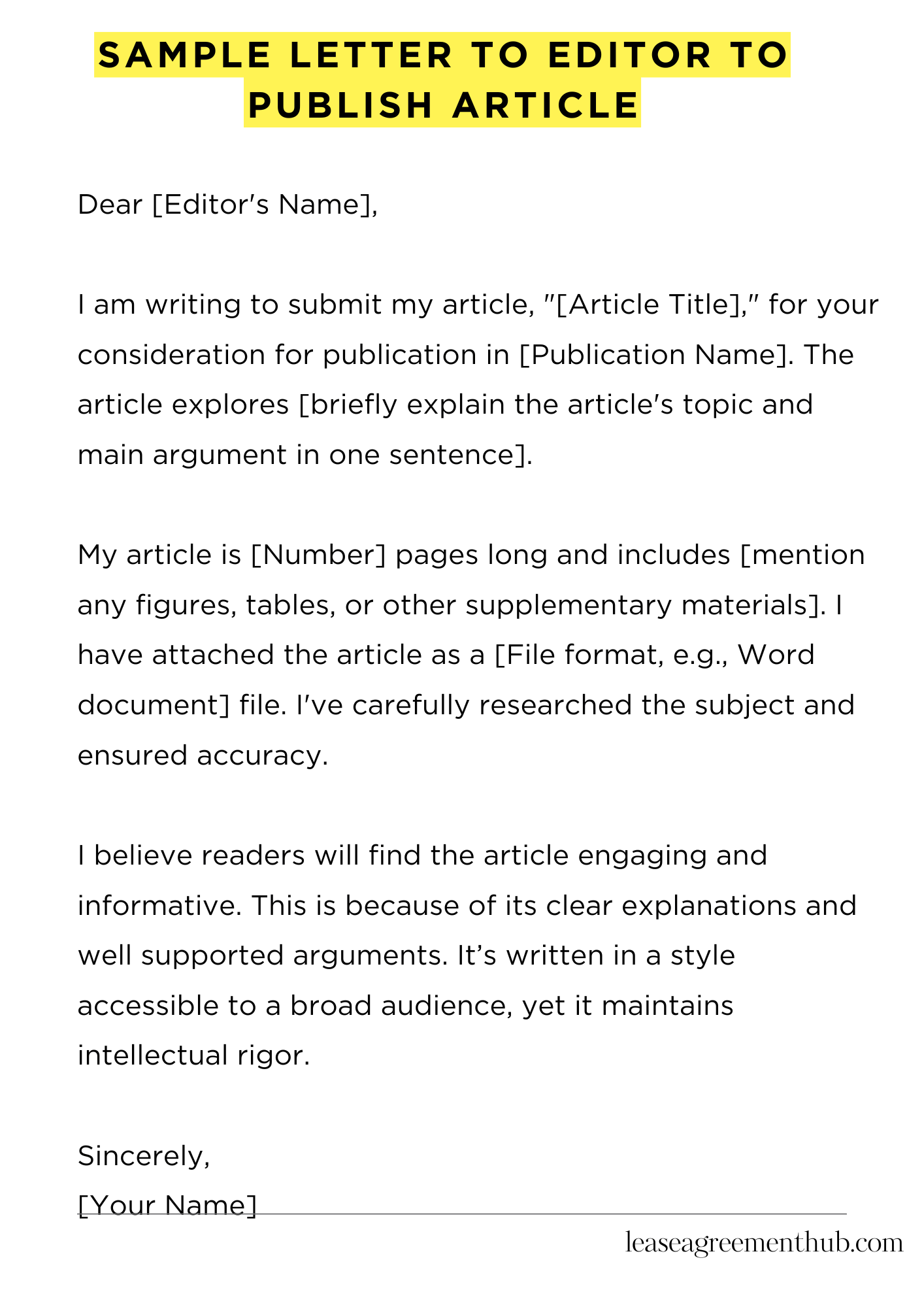A sample letter to the editor is a template. It shows you how to write a letter asking a publication to print your article. Its purpose is to help you get your work published.
This article gives you examples. These examples are ready-to-use templates. They’ll make writing your own letter much easier.
We’ll share various samples. You can adapt them to your needs. Writing a great letter will be a breeze!
Sample Letter to Editor to Publish Article
[Your Name]
[Your Address]
[Your Phone Number]
[Your Email Address]
[Date]
[Editor’s Name]
[Publication Name]
[Publication Address]
Dear [Editor’s Name],
I am writing to submit my article, “[Article Title],” for your consideration for publication in [Publication Name]. The article explores [briefly explain the article’s topic and main argument in one sentence]. It offers a fresh perspective on [mention a key aspect or unique contribution].
My article is [Number] pages long and includes [mention any figures, tables, or other supplementary materials]. I have attached the article as a [File format, e.g., Word document] file. I’ve carefully researched the subject and ensured accuracy. The information presented is both timely and relevant to your readership. I am confident it aligns well with the publication’s focus on [mention specific areas of the publication’s focus].
I believe readers will find the article engaging and informative. This is because of its clear explanations and well supported arguments. It’s written in a style accessible to a broad audience, yet it maintains intellectual rigor.
Thank you for your time and consideration. I look forward to hearing from you soon regarding the possibility of publication. I am available to discuss the article further if needed.
Sincerely,
[Your Name]

How to Write a Sample Letter to the Editor to Publish an Article
Understanding Your Audience: The Crucial First Step
Before even considering the salutation, analyze your target publication meticulously. Its editorial stance, typical reader demographics, and past published articles are all crucial. This pre-writing reconnaissance mission is paramount. A poorly targeted letter is a guaranteed missive destined for the circular file. Tailor your approach to resonate with the publication’s ethos.
Crafting a Persuasive Opening: Hooking the Editor
Your opening gambit must be compelling. Forget tepid introductions; instead, immediately highlight the unique value proposition of your intended article. A strong thesis statement, succinctly summarizing your core argument, is essential. Begin with an arresting hook – a provocative question, a startling statistic, or a pertinent anecdote.
Showcasing Your Article’s Merit: The Argumentative Core
This section requires a deft touch. Articulate the article’s significance with precision and verve. Don’t merely summarize; demonstrate the originality and scholarly rigor of your work. Highlight the article’s unique contribution to the existing body of knowledge. Use persuasive language, showcasing your expertise subtly.
Highlighting Your Credentials: Establishing Authority
Briefly mention your relevant qualifications and experience. This is not about self-aggrandizement, but about establishing credibility. A concise yet impactful statement of your expertise lends gravitas to your submission. Remember, authority begets trust.
Formatting for Clarity: Presentation Matters
A well-structured letter is as crucial as its content. Maintain a professional tone throughout. Use clear and concise language, employing short paragraphs to enhance readability. Proofread meticulously; grammatical errors are unforgivable. Adherence to the publication’s submission guidelines is non-negotiable.
Concluding with a Call to Action: A Poignant Plea
Your conclusion should reiterate your article’s value and express your keen interest in publication. Include your contact information clearly. A polite yet confident expression of anticipation adds a professional flourish. Reiterate your eagerness to contribute to the publication’s esteemed repertoire.
Sample Letter Structure: A Practical Example
Consider this skeletal structure: [Your Name and Contact Information] → [Date] → [Editor’s Name and Publication Title] → [Subject Line: Concise and Informative] → [Compelling Opening Paragraph] → [Article Summary and Value Proposition] → [Author Credentials] → [Call to Action and Contact Information]. Adapt this template to suit individual circumstances. Keep it succinct and impactful.
FAQs about sample letter to editor to publish article
Submitting an article for publication can be daunting. A well-crafted letter to the editor is crucial for a positive outcome.
What information should I include in my letter to the editor?
Your letter should concisely state the purpose of your submission, highlighting the article’s key arguments and relevance to the publication’s readership. Include your name, contact information, and a brief summary of the article’s content and its significance. Mention any relevant credentials or expertise you possess.
How long should my letter to the editor be?
Brevity is key. Aim for a concise letter, typically no more than 200-300 words. Editors are busy, so a clear and succinct letter increases your chances of acceptance.
What is the best way to format my letter to the editor?
Use a professional and formal tone. Use a clear and simple font, such as Times New Roman or Arial, in a readable size (12pt). Maintain a consistent format, including proper paragraphing and spacing. Proofread carefully for any grammatical errors or typos.
Where should I send my letter and article?
The letter and article should be sent to the appropriate editor of the publication. The contact information is usually available on the publication’s website, often under a “Contact Us” or “Submissions” section. Follow their submission guidelines carefully.
What if my letter to the editor is rejected?
Rejection is common in publishing. Don’t be discouraged. If your letter is rejected, consider revising your submission based on any feedback received, or try submitting to a different publication. Another publication may better suit your work.
Related: